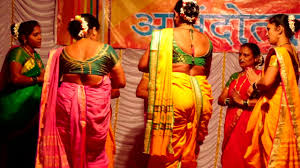Fading Folk Theatre of Santhal Tribes of West Bengal, India- "Chadar Badar Puppetry "
Puppets are mainly of four types largely known to all in the world. They are Glove Puppets, String Puppets, Shadow Puppets, and, Rod Puppets. Most of the puppets existing around the world come under either of them. Some vary in sizes too and some adopt a combination of two or more. Chadar Badar does not fall under any of them. It is yet another type of unique puppetry called Chadar Badar of puppetry practiced by Santhal Adivasis of West Bengal and Jharkhand regions of India. Adivasis means Tribes. It is distinct from the common forms of puppets that are prevalent in other parts of India. The puppets are seven to nine inches long, and some are even five to eight inches carved out in wood and their movements are guided by a wonderful mechanism, supported by many levers. The puppeteer tugs the main cord which pulls the main lever, which in turn pushes a few small sticks upward and some downward; the limbs of the miniature puppets are attached to these sticks to make the puppets move. The puppeteer follows the beat of the drum and makes the puppets dance in unison.
Chadar Badar is a much less known puppetry prevailing among the Santhal tribes. It is neglected to the point of near extinction, hardly one or two tribal puppeteers are alive today. There is a central bamboo rod(stuck in the earth or held by one hand), which has a circular wooden platform on the top, carrying a number of puppets on it. There is a leader puppet-maiden and a youth in various dancing poses who face each other and execute a series of movements, apart from playing drums and flutes.
The puppeteer performs in the open fully covered by a red cloth, accompanied by santhali songs and dance dolls. The puppets are simply clothed with painted facial features and often carry a turban or bird-feather on the head. It is to be believed that these simple puppet dances represent the first primate form of puppetry before the storytelling in the epic tradition came into vogue.
Mr. Ravi Dwivedi from New Delhi has made an intensive study on this art form. In his own words
"I first saw a dismantled set of Chadar Badar puppets tucked into the thatched roof of a tribal house in a remote village of Dumka district of Jharkhand. It was then (1985) trekking for documentation of tribal/folk art, in the interior of the Santhal Pargana area, and was soon to find out that Chadar Badar is a unique form of puppetry practiced only by Sathal adivasis".
Sadly, there is no printed material available on such decaying art forms in India and Chadar Badar is no exception. Even Anthropologists, Folklorists, Crafts, and Puppetry Experts have failed to record, gather and note the information about this tribal group, their art, and culture, and about the Chadar Badar puppetry.
Is Modernization, the present Economic scenario, and the unreasonable growth of other forms of entertainment responsible for the decaying of this art form?
Last year I had an opportunity to watch Cadar Badar's performance at Dhaatu International Puppet Festival 2018, Bengaluru.
It was quite impressive to watch the troupe members dancing to the music and also manipulating puppets.























Comments